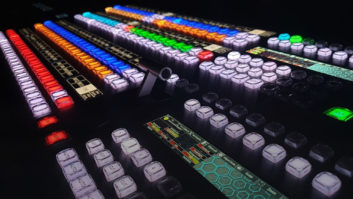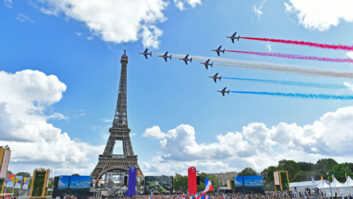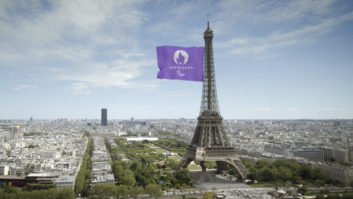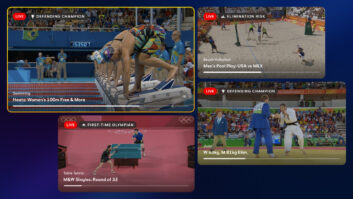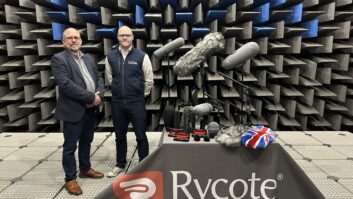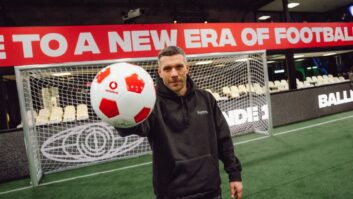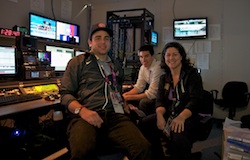
NBC had a huge presence in London for the Olympics, taking up more space in the International Broadcast Centre than OBS and the BBC combined. It had some 2,800 people in London plus 700 in New York working on the Games. “It’s a pretty enormous effort to go from about 100 to 120 year-round employees,” says NBC’s Director of Post Production Operations, Darryl Jefferson.
To make this work, it had to rely on a transatlantic workflow it has perfected over numerous Games. This will form the basis of its new sports facility in Stamford, Connecticut due on air early next year.
Jefferson believes that the way the Blueorder (now Avid) MAM system has developed has “been a significant game changer. We can move files from London to New York, Telemundo in Florida, Comcast in Denver, and all business units can essentially self-service their content needs. Whether it’s on EVS or a deck in New York, you can move it with a click and a drag.”
Previously, “we had to re-build and re-think every time we built a content factory for each Games, but this will become our system for Stamford and our workflow for future Games.”
About one-third of the equipment it assembled for London will move on to Sochi for the 2014 Winter Olympics, another third will be used in Stamford, and the rest returned to vendors or hire companies. “We are re-using much more stuff than ever before,” he says.
“During previous Olympics we were developing file-based workflows, but now people are comfortable using the tools,” says Matt Adams, VP, Solutions Architecture, Harmonic, who worked for NBC Olympics from 1996 to 2006 (and has been part of the team at each Olympics since). “Each one we were tasked with making more content, more efficiently. We would test at each Olympics new ideas of how this might work, including leaving people at home and electronically hooking them up with the content.”
For 2008 NBC’s experimental workflow saw content ingested in Beijing, Omneon equipment making high-res and proxy copies of each source, and about 50 operators in New York doing selection and sending it to Avid or creating a simple cut piece.
For 2010, it tried a version of that in Vancouver with an EVS workflow, but no proxies. All high-res content was stored on Media Grids and the operators were in the IBC.
By London, the Blueorder system NBC used first at Beijing had become part of Avid, integrated with Interplay. It was used with a large Media Grid streaming content locally, with about 50 users across news and sports at the IBC. There were also six STM-16 2.4Gbps data pipes (about 2Gbps each after overheads) to New York, where an additional 50-plus operators had access.
The data pipe was large enough for the first time to move both high-res and proxies. It meant NBC could archive to an LTO robot in Stamford as it came in, and “whether you’re in London, New York, or elsewhere, if you have the rights, you can access the full archive online.”
At the IBC, HD streams went into 32 XDCAM XDS-PD1000 Media Stations, each with 1TB of storage, an XDCAM drive and Ethernet, for FTPing high-res and low-res versions to the Media Grids. The resulting files were 50Mbps XDCAM, NBC’s production and archive format. NBC has clients using the system plus multiple news outlets. “So, the faster you get the material into archive, the more valuable it is,” says Adams.
The two main Media Grids in use for the Games will become the central store in Stamford, where it will have 10 four-channel 1RU Media Deck 7000 devices for ingest.
London bottlenecks
“Can you think of a worse place to test all your new equipment than the Olympics,” but “that type of testing and discovery is invaluable,” says Adams. The system worked, but there were bottlenecks, and over the course of the Games NBC came up with improvements that will be useful for the new 24/7/365 facility.
“This is the first Olympics that NBC has aggressively used IP infrastructure. All the delivery is IP, as is content creation – both the Highlights Factory (Avid MAM and Media Grid) and the EVS IPDirector set up. The two separate file-based workflows use Media Grid as the central repository, while the Avid MAM knows about the content on the EVS systems. It is significantly integrated from the metadata standpoint.”
The Avid MAM was considerably enhanced for the Games, with lots of interconnections with Interplay PAM, enhanced archive tools, and a new viewer that offers more efficient clip selection. The EVS system was used mainly to create clip packages for live shows. The Avid MAM tool for more finished clips.
NBC also had three A venues (athletics, swimming and gymnastics) with standalone outside broadcast units and cameras but also taking ISO feeds of all the OBS cameras, sending only the programme feed to the IBC. Each had a smaller Media Grid controlled via local EVS units. The additional storage meant that each OB could store the entire event while wiping each EVS system after a day’s competition.
At the IBC, NBC had two studios (15x15m and 12x12m). For efficient construction, it uses eight RIBs (Racks In a Box). These pre-wired units were used for the first time at Sydney, fit in a 20ft ISO sea container and contain 20 racks (10 each side).
File fetch and carry
With so much content to collate, NBC had a team of five Fetchers to find files, whether in London or New York, on the Media Grids or EVS systems, create clips and do standards conversion. “It means editors can get on with editing while the Fetchers fetch,” says Adams.
“We have a crew in New York, at 30 Rock, and we can’t have everybody out here. Primetime and Daytime are done here, back at home we have MSNBC, NBC Sports, CNBC, Bravo,” says Fetcher/AP, Katie Morgan (pictured, right).
Fetchers were first used in 2008 and have access to all the melts (ISO feeds, such as high speed cameras) and features (some of which are created at the venues), push them to the different departments (who can’t otherwise see them) and load them into the Media Grids. Their highlights and clip clearing house also has a couple of staff responsible for NBC promos. “It has helped immensely with workflow,” says Adams.
By David Fox

